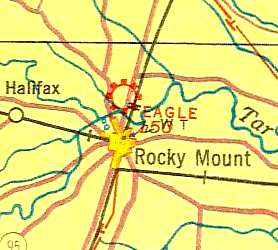
Eagle Airport / Rocky Mount Municipal Airport (RMT), Rocky Mount, NC
35.96 North / 77.79 West (East of Raleigh, NC)

Rocky Mount "Eagle" Airport, as depicted on the 1935 Norfolk Airway Chart.
The date of construction of this former municipal airport is unknown.
The earliest reference to Rocky Mount's Eagle Airport which has been located
was in The Airport Directory Company's 1933 Airports Directory (courtesy of Chris Kennedy).
It described Rocky Mount's "Eagle” Airport as a commercial field located ½ mile north of Rocky Mount.
The airfield was said to consist of a 4-acre rectangular sand & sod field,
measuring 1,400' by 1,200'.
The 1934 Department of Commerce Airfield Directory (courtesy of Chris Kennedy)
listed Rocky Mount "Eagle Airport" as a municipal airport,
located "One mile north of Rocky Mount, just north of Tar River on west side of Highway #40."
The airfield was described as consisting of a rectangular sand & clay field,
measuring 3,600' north/south by 1,400' east west.
Hangars & buildings were said to be located along the southeast side.
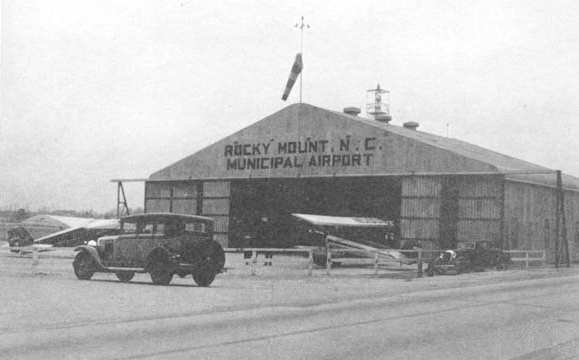
The airport was evidently renamed Rocky Mount Municipal Airport at some point between 1934-36,
as that is how it was labeled on a hangar pictured in the 1936 book "Emergency Relief in North Carolina" (courtesy of Nick Demilio).
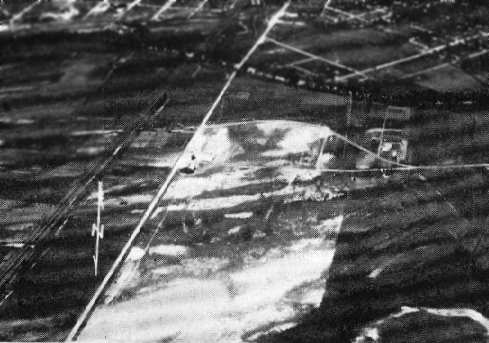
An aerial view looking south at Rocky Mount Municipal Airport
from the Airport Directory Company's 1937 Airports Directory (courtesy of Bob Rambo).
The field was described as having a 3,600' x 1,500' sand & sod landing area.
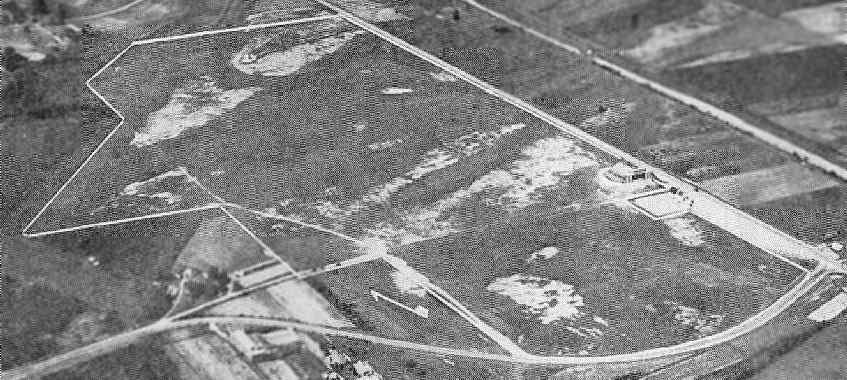
An aerial view looking northeast at Rocky Mount Municipal Airport
from the Airport Directory Company's 1941 Airports Directory (courtesy of Chris Kennedy).
The field was described as having a 3,600' x 1,800' sand & sod landing area.
A single hangar was depicted on the east side of the field.
The directory contained an advertisement for the Rocky Mount Flying Service.
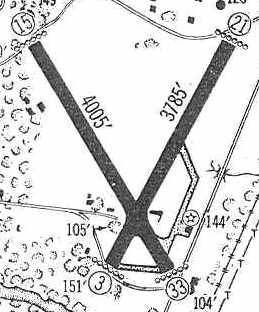
The 1960 Jeppesen Airway Manual (courtesy of Chris Kennedy)
depicted Rocky Mount Municipal as having two paved runways (4,005' Runway 15/33 & 3,785' Runway 3/21),
as well as a taxiway leading to a ramp on the southeast side of the field with a single building (a hangar?).
Rocky Mount Municipal Airport was described in the 1962 AOPA Airport Directory as having two paved runways,
and the operator was listed as Rocky Mount Air Service.
The Aerodromes table on the 1965 Norfolk Sectional Chart (courtesy of John Voss)
described Rocky Mount Municipal as having two asphalt runways, with the longest being 4,005'.
In the words of Joe Benson,
"I flew a Cessna 210 from Opa Locka up to RMT in 1967 & I landed on Runway 21.
The next night, [I departed] off of Runway 3.
The only buildings even then were the FBO right on US 301."
Rocky Mount Municipal Airport was renamed Rocky Mount Downtown Airport
at some point between 1965-72,
after the larger Rocky Mount Wilson Airport had been built to the south.
"Rocky Mount Downtown" Airport was depicted on the August 1972 Charlotte Sectional Chart (courtesy of Robert Brown)
as having two paved runways, with the longest being 4,000'.
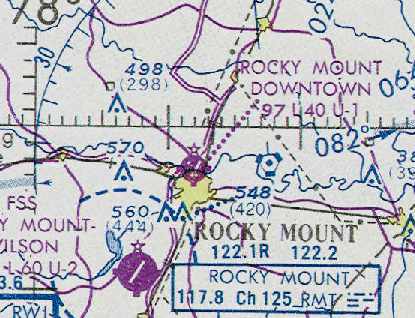
"Rocky Mount Downtown" Airport was depicted on the November 1976 CG-21 World Aeronautical Chart (courtesy of Chris Kennedy)
as having two paved runways, with the longest being 4,000'.
Rocky Mount Municipal was evidently closed at some point between 1976-93.
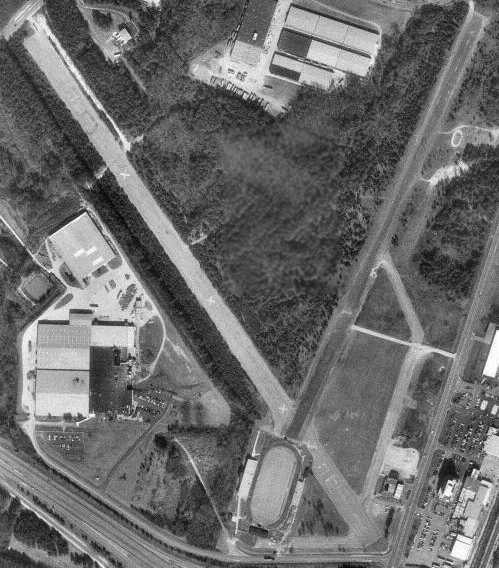
As seen in the 1993 USGS aerial photo,
both runways still remained intact, marked with closed-runway "X" symbols.
Joe Benson continues, "The parking ramp was still there when I visited in 1994 but no buildings of any kind.
The stadium was there but you could drive the full length of both runways.
I was sitting on the centerline in my Bronco & a cop came by & just stared at me but didn't stop.
A penny for his thoughts. I guess he couldn't tell when someone is reminiscing."
Adelia Ramey (of the City of Rocky Mount's Department of Planning & Development) recalled in 2005,
“When we first moved here in 1997 the site was used for recreational soccer.
There were 1,000 kids & their families swarming all over the fields
and using the runways as a parking lot.
That stopped about six years ago [1998] when they discovered the contamination.
It was from the crop dusters dumping out their tanks on the ground.
It took a long, long time to clean up.”

A 2000 photo by Paul Freeman looking northwest along the abandoned Runway 33.
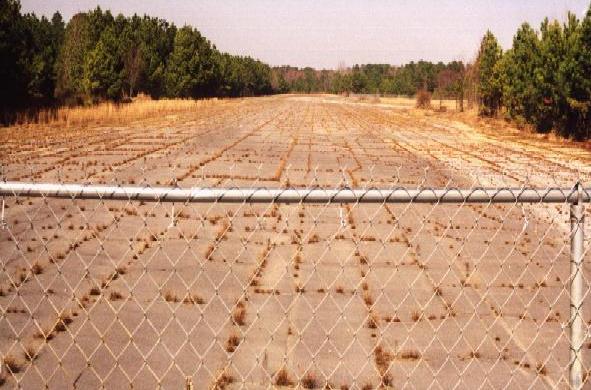
A 2000 photo by Paul Freeman looking northeast along the abandoned Runway 3.
Paul Freeman visited Rocky Mount Municipal in 2000,
to find that both runways are still very much in existence.
A small football stadium has been built on the portion of Runway 3/21
below the runway intersection, and Runway 15/33 is apparently
used for parking for stadium events (and is open & accessible by car).
Most of the northern end Runway 3/21 is fenced off, with a sign
indicating that it will not be open for public access until cleanup
of hazardous materials is complete (buried fuel storage tanks?).
No evidence of hangars or other former airport buildings was noticeable.
Rocky Mount Municipal was still depicted on 2002 sectional charts as an abandoned airfield.
Rocky Mount resident Nick Demilio reported in 2003,
"The old runways are still there.
They have been used as storage pads for various materials by the city (recycling collection points),
for people to take their teenagers out to practice driving away from the traffic, and not much else.
The city built the 'Rocky Mount Athletic Complex' there over 20 years ago.
Rocky Mount Senior High plays its home football games there.
The city has been talking for years about turning the rest of the 'old airport' property
into a more ambitious municipal athletic complex with many baseball, softball, and soccer fields.
That plan is supposedly ready to start building after being held up by the hazardous waste found there...
not old aviation-related stuff but PCB's contaminating the soil - how they got there I don't really know.
It is an official 'Superfund' site and has been cleaned up.
The pavement is cracking but still drivable,
and some of the old markings painted on the runways are still there."
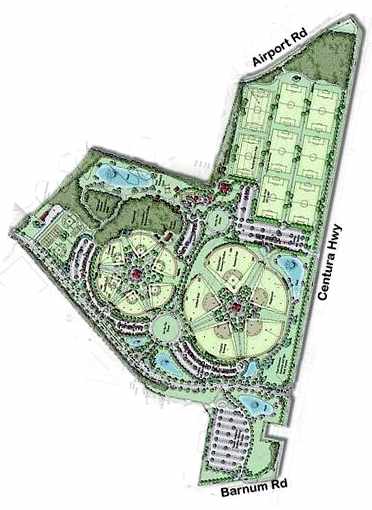
In 2005, the City of Rocky Mount's website described the “Rocky Mount Sports Complex” as “opening Fall 2006”.
It said “Work on the Rocky Mount Sports Complex is moving forward at a rapid pace,
and the old airport grounds are moving aside for 'fly balls' instead of flying planes.”
It was reported in 2005 that “The local school board is trying to negotiate
the northern end of that property from the City to use to put in a new high school.
This would come at the expense of land for soccer fields.
The city is not keen on the idea, having already invested heavily in design & site changes.”
____________________________________________________